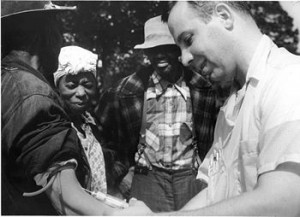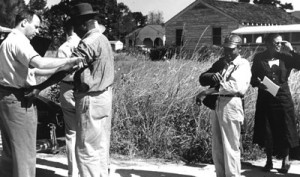Louis (or Lucas) Santomee
![caduceus[2]](https://blackusa.com/wp-content/uploads/2012/10/caduceus2.jpg) Louis was the first university-trained black physician, who after completing studies in Holland, practiced medicine in the colony of New Amsterdam (New York). In 1667 he received a land grant for his services.
Louis was the first university-trained black physician, who after completing studies in Holland, practiced medicine in the colony of New Amsterdam (New York). In 1667 he received a land grant for his services.
![caduceus[2]](https://blackusa.com/wp-content/uploads/2012/10/caduceus2.jpg) Louis was the first university-trained black physician, who after completing studies in Holland, practiced medicine in the colony of New Amsterdam (New York). In 1667 he received a land grant for his services.
Louis was the first university-trained black physician, who after completing studies in Holland, practiced medicine in the colony of New Amsterdam (New York). In 1667 he received a land grant for his services.
Mary Eliza Mahoney was the first African American nurse to study and work professionally in the United States. She was also a co-founder of the National Association of Colored Graduate Nurses (NACGN) with Adah B. Thoms.
Mahoney was born in Dorchester, Massachusetts in 1845 (her exact birthday is unknown), to Charles and Mary Jane Sterwart Mahoney. She grew up with her parents, a sister and one brother in Boston, Massachusetts where her interest in nursing began as a teenager. (more…)
A scientist and educator, Dr. Charles Buggs, of Brunswick, Georgia, conducted special research on why some bacteria (germs) do not react to certain medicines. In several articles, he presented his ideas on penicillin and skin grafting, and the value of chemicals in treating bone fractures.
In 1944, he contributed some of the results of his research to the world through 12 studies he helped to write. Three years later he wrote an important article on how to use germ-killing chemicals (antibiotics) to prevent and cure certain diseases. he also taught college biology, and made studies and suggestions on premedical education for African Americans. Dr. Buggs’ research and teaching contributed to a better understanding of health and of the human body.
Jane Cooke Wright was born in New York City in 1919. Her father, Corinne Cooke Wright is well known for his cancer research, and being a civil rights leader and cancer researcher.
Jane graduated from Smith College in 1942. She graduated from New York Medical School in 1945. She interned and did her residency at Bellevue Hospital and Harlem Hospital respectfully from 1945 to 1947.
Wright worked with her father at the Harlem Cancer Research Foundation from 1947 to 1952. She researched cancer chemotherapy here. Jane was named director of Harlem Hospital Cancer Research Foundation in 1952. She became an instructor and director of cancer research at the New York Medical School. Wright was named associate dean of the school and became the first black physician to do so. Currently she is a professor emeritus at the school.
1883-1959. William Augustus Hinton was born in Chicago, Illinois on December 15, 1883. After two years at the University of Kansas (1900-1902), he earned a Bachelor of Science from Harvard University in 1905. Lacking the funds for medical school, William Hinton taught at Walden University, Nashville, Tennessee, and in Langston, Oklahoma for four years. During the summer months he continued his studies in bacteriology and physiology at the University of Chicago. William Hinton entered Harvard Medical School in 1909 and earned a M.D. from Harvard Medical College (with honors) in 1912, completing his degree in only three years. (Aside: “The [Harvard] Medical School offered him a scholarship for Negro students, but Hinton refused the offer.
In competition with the entire student body he won the Wigglesworth Scholarship and the Hayden Scholarship.” Source: DNB p.315.) After graduation from Harvard Medical School in 1912, Hinton worked for the Wasserman Laboratory, which at that time was part of the Harvard Medical School. In the mornings he was a volunteer assistant tin the Department of Pathology of the Massachusetts General Hospital. At the Wasserman Laboratory, Hinton began teaching serological techniques. (more…)

 From 1932 to 1972, 399 poor black sharecroppers in Macon County, Alabama were denied treatment for syphilis and deceived by physicians of the Unites States Public Health Service. As part of the Tuskegee Syphilis Study, designed to document the natural history of the disease, these men were told that they were being treated for “bad blood.”
From 1932 to 1972, 399 poor black sharecroppers in Macon County, Alabama were denied treatment for syphilis and deceived by physicians of the Unites States Public Health Service. As part of the Tuskegee Syphilis Study, designed to document the natural history of the disease, these men were told that they were being treated for “bad blood.”
In fact, government officials went to extreme lengths to insure that they received no therapy from any source. As reported by the New York Times on 26 July 1972, the Tuskegee Syphilis Study was revealed as “the longest nontherapeutic experiment on human beings in medical history.” (more…)